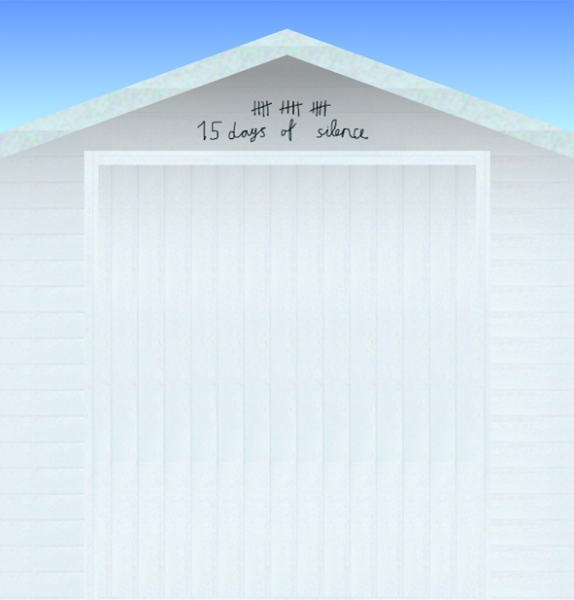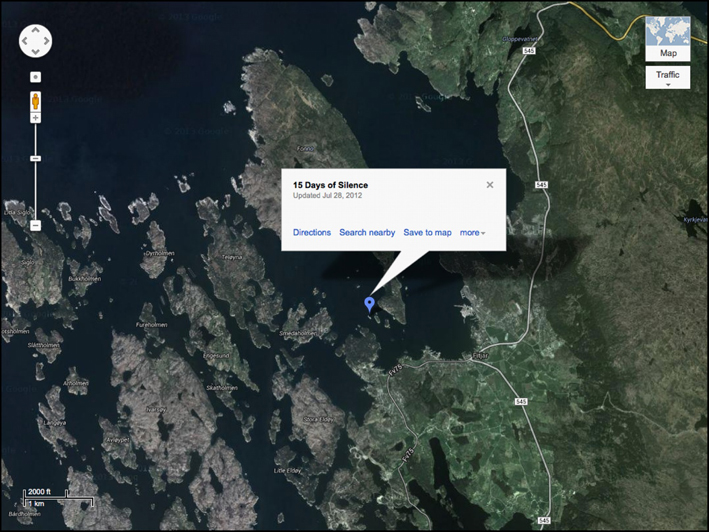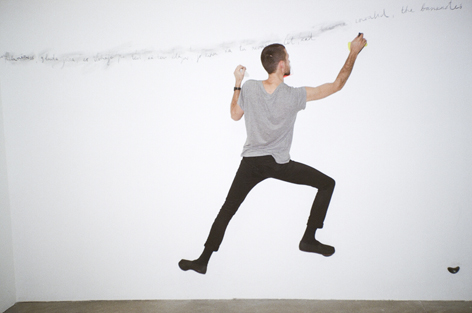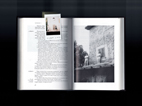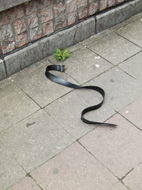text
Let me google that for you
Miks Mitrēvics + Kristīne Kursiša
MIKS MITRĒVICS + KRISTīNE KURSIŠA
Let me google that for you
18.01.2014 > 09.03.2014
This exhibition carries the title of a long-term collaboration project between the Latvian artists Miks Mitrēvics (b. 1980) and Kristīne Kursiša (b. 1979), who since 2003 work together on an occasional basis. The nucleus of this project is a type of personal diary that is built from a compilation of daily observations, photos, notes and comments, made in different cities, at different times and in varying circumstances. The infiltration of fragments from the daily personal lives of the artists within their artistic journey gradually absorbed both the private sphere as well as the entire artistic space with a form of creative photosynthesis.
Excerpt from Miks Mitrēvics & Kristīne Kursiša book Seven Thursdays. A Dialogue for Two. 2014.
–
KK:
Please tell more about this project.
MM:
Two Norwegian artists who were organising an independent project in Fitjar, Norway approached me. The location for the project was a group of small islands in the sea. Each of the artists had their own island for expressing themselves. There were 16 artists and 16 islands. The islands were ours for two weeks, except the last weekend when they were made available for the public through organized boats and guides. It was my second year in Belgium and my daily routine consisted of HISK parties and countless visiting lecturers, and I spent most of the time in discussions. Therefore, it seemed natural for me to use this time to pause all the talking. So I wrote the manifesto, moved to the island and stopped talking for 15 days.
–
KK:
Could you disclose the Manifesto?
MM:
15 days of silence
15 days, the most valuable thing I can do is to be silent.
15 days, I turn off the computer and cell phone.
15 days, I live alone with the nature.
15 days, I forget my daily rhythm.
15 days, I get up with the sun.
15 days, I read seven books.
15 days, I cook and wash my clothes myself.
15 days, I wave my hand at every passing boat.
15 days, I make my own mistakes.
15 days, I go to swim once a day.
15 days, I respect the written word and I do not waste it.
15 days, I focus on the present and forget the past and the future.
15 days, I go to sleep as the sun goes down.
15 days, I wear warm clothes in cold nights.
15 days, I write down everything without thinking much.
_
This work came forth during the time when I had settled for 15 days on a small, deserted island in Norway. I decided to spend all of this time in complete silence. There was nothing but the bare essentials and 7 books with me. I made a shed for myself and commenced the circle of reading. I read every day and took notes – writing down the most significant ideas. Later on, to minimize distance to myself I decided to combine reading with a physical activity. This is how “The Circle of Reading” began (“Круг чтения” is borrowed from Lev Tolstoy’s book by the same title, MM). For several hours a day on the coast line – the site where the sea met the bedrock – I wrote down the most recent notes. Circle after circle the writings stretched all around the island, but as waves washed against the rock these were disappearing quickly, giving room for new ones.
KK:
A Circle of Readings, Riga, 06.12.2012. was in fact a continuation of that very Manifesto. It became another task for you, a sort of a resolution to be practiced every day. In the description of the work you mention that you started this ritual in order to get distracted from yourself. How did the silence and being alone influence you?
MM:
Silence is an organic part of me, and a necessity at once, and I feel very good in this state. Whilst on the island, it gave impulses to other means of expression. I was listening a lot and was very open to everything that happened. I can’t remember any other time where I spent so much time reading books or writing letters. There is a tendency of being caught in an inner loop when you’re alone. The books I had brought with me helped me to organize my daily life and information space. The books were a way for me to broaden the circle of thinking and keep a healthy distance from myself. The time spent in silence flows differently; it is monolithic and does not have interruptions. At the end of every day spent in silence I drew a line above my door. As weird as it might sound now, it truly was the way of counting the days of silence and separate one day from another.
KK:
A Circle of Readings, Riga, 06.12.2012. gave way to both you reading and writing endless synopsis while on the island. What were the books you had with you? Which one did your arm stretch to every day and which were the ones that stayed on the shelf and why?
MM:
I had 7 books with me: two volumes of Wise Thoughts for Every Day by Leo Tolstoy; Oxford Advanced Learner’s Dictionary; Epiphanies by Imants Ziedonis; The Tokyo-Montana Express by Richard Brautigan; 104 Stories by Thomas Bernhard; Of Walking in Ice by Werner Herzog; and Faserland by Christian Kracht. Initially I tried to read them simultaneously, an excerpt from a book at a time. However, as time went by, I moved to reading the whole books, from cover to cover. Herzog’s Of Walking in Ice and Brautigan’s The Tokyo-Montana Express were very inspiring, with their daily lightness and fundamental remarks. Tolstoy’s Wise Thoughts were a heavyweight material requiring a considerate rationing to avoid slipping into melancholy. It is a very valuable book but just as with Oxford Advanced Learner’s Dictionary suitable only for fragmentary reading. Ziedonis’ Epiphanies I like a lot, however, they somehow seemed too romantic for the situation. The only book left unopened was Kracht’s Faserland, lacking just one more day of silence. These books existed in the context of my bookshelf, a chronic lack of time and a long-time wish to read them.
KK:
How did the local community react to your decision to move to the local island?
MM:
At first there was a huge confusion about me being on this stone in the sea, made even more awkward by my silence. The small shed I settled in, in fact, might have been just flushed into the sea in case of a stronger storm. Luckily enough, storms in the summer are less frequent and calmer, and never came. The local interest was quite significant and my silence did not constitute a principal obstacle for communication, which, at times, did take place with someone talking from the boat and me writing on the cliff. It was nice, when one day a mother and her daughter stopped by in their canoe and left fresh strawberries for me. I wrote thank you! on the cliff.
KK:
Islands like this are used as pasture for sheep. Later your island was inhabited by two sheep, a mother and a son. You tried to minimize your contact with them in order to avoid attachment. After all, there were more important things for you to do there. But unlike you, the sheep were not constrained by such resolutions and turned out to be extremely curious. They followed each and every step you made.
MM:
True, there is a habitat of wild northern sheep species that the local farmers breed. The sheep are resistant to the harsh weather and are able to survive on a rocky island eating only the moss. For the most part they live in the wild and once a year they get fleeced. In the beginning they were afraid of me and I was afraid of them. However, as the time went on, the sheep started to follow my daily tracks and hid behind my shed during the storm. Later on we fully accepted each other and chased each other around the island.
KK:
I will never forget the phone call of August 13, 2012 at 1:01 AM. I was trying to sleep as the phone rang and there was silence on the other end. The fifteenth day of your silence was over, so you called right at midnight but could not talk. Recently you told me that you actually had a stroke of paranoia on the island in fear that you might not be able to ever speak again.
MM:
When some seven days had passed I started to think that there was atrophy in my vocal chords and I will not be physically able to speak ever again. I remember that it was the only time I uttered a quiet sound to be sure I am still able to do something like that.
KK:
Did you manage to fulfil every point of your Manifesto? What did this experience give you, what conclusions and revelations did you draw from it?
MM:
I have not analysed it but I think I did. In fact even before the project began I knew, you don’t have to go to an island to change something, a simple determination will do. Renouncing and leaving something often means the opposite – gaining space and time for something new.
KK:
You could have chosen to demonstrate the documentation of A Circle of Readings – the very ritual you performed on the island day by day. Instead you chose to repeat the experience once more in the framework of seven Thursdays, an obviously more difficult path.
MM:
This was a result of our conversations. We decided to reiterate A Circle of Readings as a performance using cliff climber’s hooks. The same synopses that I wrote one after the other on the rocky coast of the island were written by climbing the walls of the exhibition hall. Whilst doing it on the island I loved the sheer mix of this endeavour: as thoughts wander around the writing on the wall, you have to try to balance physically on the steep coastline and avoid falling into the water. I remember how the repetition of those texts coupled with the exercise load, after some time, caused a specific state of trance and euphoria. This is the reason why repetition of writing on vertical walls of the gallery became a logical continuation of this physical and mental exercise.
_
Color works
KK:
As far as I remember, it all started from the thick fog we saw on the way to Kalnciems, in summer 2012. You stopped the car and literally dived into the depths of the meadow. Afterwards you had the idea to focus upon fixation of the color of this or that observation, and you bought a colour palette that you now bring on each and every trip.
MM:
To be honest, I don’t remember this incident as clearly, but it is interesting that you do. That is true, at some point I started to use Pantone color scale as some kind of diary where a certain coloring usually observed somewhere in nature, serves as a reminder for a certain experience or a thing. Currently, in fact, we are working on an exhibition where among other works we will include nine colors signifying certain events of the last two years.
KK:
The first time the color pattern made was used during your trip to to the island in Fitjar. Once you came back you already had a small collection of colors, each of them leaving a trace in time you spent on the island. One of them is PANTONE 5803 – Ginger Tea. Fitjar, 07.08.2012. Contemplating on this work, I always try to imagine how it actually happened . Were you scared? A practically non-existent link to the outer world, a floating postbox in the water and a disassembled phone in case something extraordinary happens.
MM:
Locals had been warning me for a long time that I take on great risks by building my tiny shed on this small island due to the strong storms. When I saw a storm approaching I bound constrictors around my shed and supported it with poles. This did not prevent the shed from crackling all over while the storm lasted. I just tried to stay calm, made tea and chose an appropriate Pantone colour for that. As I went to sleep, all I had left was a hope for the better.
_
Tempo di Viaggio
KK:
Tempo di Viaggio. San Gregorio Da Sassola, 28.09.2011. was a journey built on a route of personal interests. We wanted to find where Andrei Tarkovsky‘s Nostalghia was shot and see it for ourselves. Later on, after reading his diary we added to the itinerary places he lived and travelled in Italy. We found a couple of old photos I once bought in the antiques shop on Kr. Barona Street with views from islands in Italy. There was much more we wanted to find for no specific reason, just for ourselves. Consistently, the impressions from this trip served as a basis for the whole series of works. Please, tell us about the things you found personally significant for yourself in this trip.
MM:
We bought tickets to Rome. There we rented a car, thus gaining a remarkable level of freedom for the trip. I had an A4 Google Maps printout marked with dots signifying where we could go looking for the places shown in photos and mentioned in his diary. In a way it was an archeology of the book. Every morning after breakfast we were drawing a route of places where to go. In many ways we relied on the situation hoping it will take us to places we have to see. It seemed unbelievable to come to the ruins of the church where the last episode of Nostalghia was shot, especially because this film at some point had given us so many inspiring moments. I just found a note from September 30, 2011, made during the trip near Napoli.
‘Food 10
Ice-cream 5
Parking 6
Sandwich 4
Photo film 3
Camping 23’
KK:
Which of the places we found left the deepest impression with you?
MM:
I think it was the place Tarkovsky sketched in his diary in the last days of his life with a remark ‘a house I’ll never see’. It was his own house he never managed to finish. We spent the longest time looking for this place. All we knew was that it was located in a town named San Gregorio Da Sassola. We only had a photo with Andrei and Larisa* standing in front of this house. After circling for a while and asking locals who didn’t speak any English, we suddenly met a 15-year old boy who knew the place. It was situated in the local park and was fenced from all sides. After a while he took us to the gate and the familiar view opened to us, an alley of trees leading to a small masonry building with a tiled roof. That day the branches of trees were being cut, thus, the gates were open. After Andrei’s death Larisa sold the house and that day we met the woman who had bought it.
–
Pomelo Leaf. New York, 01.05.2012. and The Tree of Jonas and George. New York, 07.05.2012.
KK:
Both works are dedicated to the trees that at different times and under different circumstances were planted by key figures of the time. Both have been planted in New York City. We were in New York in April and May of 2012 and you went searching for those trees. Please share the stories !
MM:
On my way to New York I recalled two stories that I had heard earlier. The first was a story about two trees illegally planted by Jonas Mekas and George Maciunas at 80 Wooster Street at the beginning of Fluxus. It happened in the then industrial Soho, gradually occupied by artists in the 1960’s. George Maciunas took two trees meant for extermination from some construction site and planted them on the pathway next to where he lived. The next day two policemen came to Jonas Mekas who also lived there and demanded to move the illegal trees away. Mekas went to the basement, woke up Maciunas and passed on the demand. Maciunas responded that the policemen could move the trees themselves if they wanted to. Armed with his Bolex camera Mekas returned to the policemen with the message. After a while the police left and never came back. The second story is about an oak planted on West 22nd Street by Dia Art Foundation – a continuation of Joseph Beuys’ project 7000 Oaks. During Kassel Documenta 7 in 1982 Beuys started the project aiming at planting 7000 trees accompanied by a basalt stele. Beuys’ concept was to create a symbolic, social and self-transforming sculpture where the basalt stele will remain unchanged while the tree will grow bigger each year.
KK:
How did both stories materialize in your works? A pomelo leaf grew from Beuys’ oak?
MM:
I keep the leaves of both trees in herbarium. I framed the leaves of Jonas’ and George’s trees along with some pictures from the site. The leaves of Joseph Beuys’ oak were involved in a story I composed about a passer-by with a pomelo in a bag. The description of both works emerged while remembering the moments of slowly observing those trees across the street. Cars, dogs, people, everything flows and changes, and only we ourselves impose meaning on things.
KK:
Recently we found out that the trees planted by Jonas and George were cut down.
MM:
Yes, recently. I came across the documentation of the end of the story while searching the original story by Jonas Mekas. Thus, the herbaria I collected now can only serve as a testimony to the trees that exist merely in stories and memories.
_
Belt. Brussels, 08.06.2012. and Lemur. Riga, 22.07.012.
KK:
The work Belt. Brussels, 08.06.2012. had a counterpart in your old archive ‘Inspire’ featuring amusing and inspiring photos from 2007 or 2006, or even earlier. After some time you bumped into an identical piece.
MM:
Yes, I finally met the snake.
KK:
Ha, ha.
*Larisa Tarkovskaya, Andrei Tarkovsky’s wife
20.01.2014

